Work as Art :: Viewing Each Other as Works of Art
Part 6 of a series exploring the use of art at work and seeing work as art.
++++
At the beginning of the coronavirus pandemic, I found myself energized by the response to crisis. It was a purposeful time and I was motivated to play my part and make things work. However, by the end of that year I was intellectually and emotionally exhausted, and despite having clocked countless hours in zoom meetings with colleagues and friends, I felt disconnected and lonely
I yearn to be seen and to see and experience others in 3-D.
Now, almost two years later, the promises of the virtual realm are still not meeting my relational needs. On Zoom I feel two-dimensional, not fully seen nor understood. These days I yearn to be seen and to see and experience others in 3-D. And in these current times – of war, great divisiveness, mass murders, and more – connecting meaningfully feels like an urgent human calling, one that could literally save us. It was this thought prompted me to write this post.
Let me start with this memory… Many years ago, I participated in a five-day meditation retreat. Of the many activities we did together, one was particularly uncomfortable but ultimately transformative. The instructions were deceivingly simple. Sitting in pairs, he asked us to spend the next ten minutes looking into our partner’s eyes. Ten minutes! Yikes… At the start I was bashful, anxious, and quite uncomfortable. My heart pounded and I began to sweat. But as I settled down, and settled into my partner’s eyes, I began to shed this anxiety. What opened up in its place was grace. I began to really see my partner, appreciate her and feel her presence before me. It was beautiful and suddenly, somehow, ten minutes were over. I felt a profound connection with my partner who, ten minutes earlier, was a stranger to me. As we debriefed, I realized how this simple exercise allowed for a remarkable knowing and caring of others. It struck me then, as it does now, that this kind of connection has a transformational quality to it.
This exercise reminds me of times I have gazed at works of art for long periods of time. On one visit to Amsterdam, I had the privilege to sit before Van Gogh’s Almond Blossoms.
The piece has an obvious beauty, but as I sat and absorbed the piece, its details and personality emerged – the directional flow of brush strokes, the varied intensity of the cobalt background blue, the gnarled twists and turns of branches, and the streaks of white and yellow ochre that, from a distance, became the most delicate flowers. I absorbed a mood from the piece - a complex mixture of lightness and depth, beauty and despair, but also an explosion of joy. It is well known that Van Gogh had a troubled life, but for me this piece represents an inner beauty. I wondered to myself, what if we could see each other in this way? To gaze long enough to feel the complexity of our inner landscape? What would this mean for our relationships? For our commitments to each other and our communities?
Inspired by the potential of the long gaze, I tried this exercise at work. It was the start of a new year, so it was a perfect time to try this experiment in human connection. I gave some context and then organized our team into pairs. I provided instructions, explaining that we were going to look into our partner’s eyes for two minutes (a much shorter time than my 10-minute experience).
Many took a few deep breaths to get present, some held hands, and some giggled or groaned uncomfortably. But as the group settled into the exercise so much seemed to open up. I observed broad smiles, laughter, some tears, and beautiful expressions of appreciation. There was a palpable joyful and loving energy in the room. At the end of the exercise people embraced. It was a beautiful and memorable moment for us. We were a team that was already well established and connected, but what I experienced in that moment was remarkable. I think we all felt seen and perhaps a little more understood, 3-D.
The poet David Whyte wrote that “…to be human is to become visible while carrying what is hidden as a gift to others…” Through an activity like this, I think we allow ourselves to be seen, to offer that gift. Standing before each other, we are no different than a work of art, like Van Gogh’s almond blossoms – colorful, layered, impressionistic, heavy, and light.
Let’s all endeavor to see each other as works of art and explore the beauty that offers. And may the world be all the better for it!


